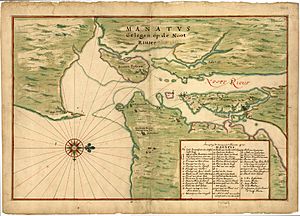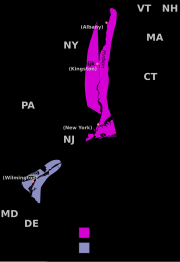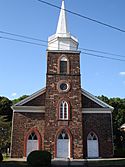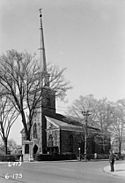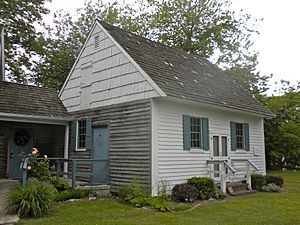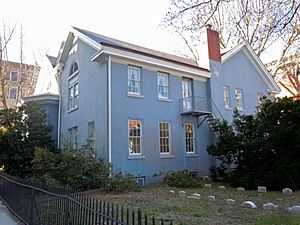Colonial history of New Jersey facts for kids
The European story of New Jersey began after Henry Hudson explored its coast and bays in 1609. Soon, settlers from the Dutch and Swedish nations started building new homes. They created colonies called New Netherland and New Sweden. In 1664, the English took control of the whole area and gave it the name New Jersey. London officially gained control in 1674 with the Treaty of Westminster. The English ruled New Jersey until the American Revolution.
Contents
First People of New Jersey
Long before Europeans arrived, the land that is now New Jersey was home to the Lenape people. They called their land Scheyichbi. The Lenape lived in the valleys of the Hudson River and the Delaware River, and the land in between. They were skilled hunters and farmers. Different groups of Lenape lived in various parts of the area, like the Hackensack, Tappan, Acquackanonk, Raritan, and Navesink tribes.
Dutch Settlements: New Netherland
In the 1600s, the Dutch started settling along the Hudson River and Upper New York Bay. They also had trading posts along the Delaware River. The Lenape people did not believe in owning land like Europeans did. However, the Dutch made sure to formally buy all the land they settled on.
The Dutch colony grew slowly. In 1658, Peter Stuyvesant, a leader of New Netherland, bought the entire area known as Bergen Neck again. In 1661, he gave a special paper to the village of Bergen. This made Bergen the oldest town in New Jersey.
Swedish Settlements: New Sweden
New Sweden was founded in 1638. It grew strongest under Governor Johan Björnsson Printz from 1643 to 1653. Printz helped the colony grow by building forts like Fort Nya Elfsborg near modern-day Salem. Towns like Swedesboro and Bridgeport were started as part of this colony. But in 1655, the Dutch took control of New Sweden.
English Takeover
The English believed they had a right to the land because John Cabot had explored North America for England before Hudson. So, in 1664, the English king gave the land that is now New Jersey to his brother, the Duke of York. The Duke sent a fleet of ships, led by Richard Nicolls, to take over the Dutch colony.
In September 1664, the English ships sailed into what is now New York Harbor. They threatened to attack, and the Dutch had to give up their colony. The Dutch didn't fight much because their trading company had not sent many soldiers to protect the colony. Nicolls became the new leader. He promised the Dutch settlers that they could keep their property, their laws, and their religious freedom.
A few years later, the English and Dutch were at war again. In 1673, the Dutch recaptured New Netherland. But in November 1674, the Treaty of Westminster ended the war, and the Dutch gave New Netherland back to the English for good.
New Jersey: A Proprietary Colony
After the English took over, King Charles II gave the land between New England and Maryland to his brother, the Duke of York. This land was renamed New York. Soon after, the Duke of York gave the land between the Hudson River and the Delaware River to two loyal friends: Sir George Carteret and Lord Berkeley of Stratton. This area was named New Jersey, after the English Channel Island of Jersey.
These two owners, called "proprietors," wanted more people to move to New Jersey. They offered land to settlers and passed a document called the Concession and Agreement. This document promised religious freedom to everyone in New Jersey, which was not common under the British Church of England. In return for the land, settlers had to pay small yearly fees called "quitrents." They also offered land to people who brought enslaved people to the colony.
Philip Carteret was chosen as the first governor of New Jersey. He made Bergen the first capital. But it was hard for the proprietors to collect the quitrents. So, in 1673, Lord Berkeley sold his share of New Jersey to the Quakers.
East and West Jersey
Because of this sale, New Jersey was split into two separate parts: East Jersey and West Jersey. This division lasted for 26 years, from 1674 to 1702. Figuring out the exact border between East and West Jersey was often a problem. The border was drawn by George Keith. You can still see parts of this old border in the lines between some of New Jersey's counties today.
Religion in Early New Jersey
Many different religious groups settled in New Jersey. After the English took over, Dutch settlers and their families spread across East Jersey. They built many towns and cities that still exist. The Dutch Reformed Church was very important to them.
Quakers were another important group. They first settled in what is now Monmouth County as early as 1664. They built their first meeting house in Shrewsbury (now Little Silver) in 1665. Many Quakers settled in West Jersey, where they started congregations and founded towns.
Other religious groups, like Baptists and Episcopalians, also built churches and communities throughout the colony.
Slavery in New Jersey
In 1804, New Jersey passed a law to slowly end slavery. With this law, all states north of the "Mason–Dixon line" (the border between Maryland and Pennsylvania) had either ended slavery completely or started a plan to end it over time.
Old Buildings
New Jersey still has many buildings from the colonial era. These old buildings help us remember what life was like long ago.
Continental Congress
Representatives from New Jersey played a part in the Continental Congress. This was a meeting of leaders from the American colonies before and after they declared independence from Great Britain.
Revolutionary War
Many important battles during the American Revolution were fought in New Jersey. This made the state very important in America's fight for freedom. Because of its key role, New Jersey is often called the "Crossroads of the Revolution" and the "Capital of the Revolution."
Images for kids



